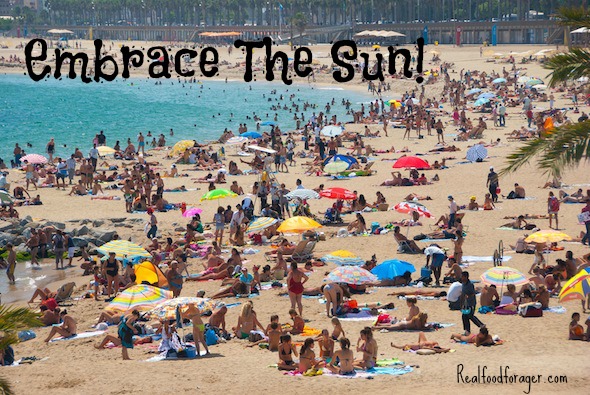
I am a sun worshiper. I admit it. I love the feel of the sun on my skin and I love how I feel after being in the sun. Here’s why I stopped using sunscreen.
I believe that blocking the sun’s rays can be detrimental to your health and use of sunscreen can be harmful. Sunbathing and sun exposure is part of being healthy when practiced with some common sense.
Stay Out of The Sun is the Conventional Advice Given
Staying out of the sun is the advice given by many health care providers. Alternatively, another piece of advice is to use sunscreen (which is toxic) to protect your skin. Over the years, with the ever increasing statistics of skin cancer reported, people have gotten so afraid of the sun they are walking around pale as ghosts and no better for it – actually worse.
The best way to get vitamin D is to expose your skin to sunshine. When cholesterol in the skin is irradiated with sunlight, the active form of vitamin D is made.
The UVB rays stimulate vitamin D production but also cause sunburn if overexposed. The UVA rays are the ones responsible for skin damage and aging. When you use sunscreen you are effectively blocking the production of vitamin D in the skin.
Most dermatologists recommend broad spectrum sun screens that block against both types of rays. If you are using a UVB block, you are also blocking the production of vitamin D.
Sunscreen Is Measured by SPF
SPF is short for Sun Protection Factor. One would think that the higher the SPF, the more protection. While this is true, once you get over SPF 30, the difference in protection becomes insignificant.
For instance, the SPF 15 blocks 94% of UVB rays, SPF 30 blocks 97% and SPF 45 blocks 98% of the rays. The higher SPF’s after 45 become fractionally better so there is no reason to spend extra money for something that is nominally higher.
Of course, the issue with conventional sunscreens are the toxic chemicals in them.
Oxybenzone is a potentially toxic substance and it is in most commercial sunscreen lotions. According to EWG’s 2012 findings, 56 percent of sunscreens contain this harmful chemical. It acts as a sunscreen by absorbing ultraviolet light. However, oxybenzone is also believed to cause hormone disruptions and cell damage that can trigger cancer.
We are advised to slather our bodies with sunscreens that have toxic chemicals that are easily absorbed through the skin.
Both the American Academy of Dermatology and the US Food and Drug Administration regard oxybenzone as safe. It’s been approved by the FDA since 1978, and is approved for use on children over the age of six months. As you know, this doesn’t necessarily mean it is safe for long term usage.
The Environmental Working Group has a database of all the studies with retinyl palmitate and they classify this chemical as high concern for developmental and reproductive toxicity. While retinyl palmitate is a type of vitamin A,
Government-funded studies have found that this particular type of vitamin A may increase risk of skin cancer when used on sun-exposed skin. However, these reports have been in mice and evidence has been inconclusive for humans.
For a good homemade sunscreen recipe made with zinc oxide click here to Mommypotamus.
Melanin
Melanin is a substance that gives the natural color to skin and hair, the iris of the eye, as well as feathers and scales. In humans, those with darker skin have higher amounts of melanin.
Melanin provides a natural protection against the harmful effects of the ultraviolet rays of the sun. However, it does not provide complete protection from the sun so even individuals with darker skin tones are still at risk from the sun’s damaging rays.
Melanocytes are cells that produce melanin which serves a number of functions in the body and these cells are found in all people. Coloration of hair and skin is determined not by how many melanocytes someone has, but how active these cells are.
Melanocytes reside in the skin and also in the brain, inner ear, heart, and eye, as well as other locations in the body. They usually are located below the surface. These cells produce melanin in response to environmental cues, including stimulation by ultraviolet radiation as well as certain chemicals.
The melanin travels out of the melanocytes and up to the surface of the tissue where the cells are found. Over time, it breaks down and needs to be replaced with fresh supplies of melanin produced by the layer of underlying melanocytes.
It’s important to get some sun exposure every day if you can. Of course if you live in places that are cold most of the time this will limit you. However, if you live in a warm climate, or at least during the warm months, you can try to get sun exposure in a sensible way to build up a tan.
The most important thing is to avoid sun burn because this has been associated with skin cancer. Sunburn can occur without your knowing it because it can take a few hours for it to blossom. So be very careful when you are out in the sun.
My goal is to get a bit of sun exposure each day for just a few minutes without any sunscreen or block, in order to start to build up a tan. After a few days of just 15 – 20 minutes, I will start to tan.
I have more of a Mediterranean type skin so I will tan. Those of you who have more delicate skin and lighter coloring will need to expose yourself for maybe 5 minutes a day until you can start to build some color, because you are at higher risk of sunburn compared with people with darker-colored skin.
I also use a wide brim hat to block sun from my face as I do not want any sun on my face. I would rather not get the wrinkles from sun exposure on the skin of my face as that skin is much more delicate then the skin on my body.
If you need to block the sun, use hats and light weight shirts, and find some shade.
After I get a good tan and I want to stay in the sun for a longer period of time I will then apply a sunscreen without the toxic chemicals. These may not work as well, so I will also be more vigilant at these times. I also seek out shade, and if I go to the beach I bring a beach umbrella.
Vitamin D is protective against certain types of cancer including melanoma. This study published in the European Journal of Cancer found that melanoma patients who exposed themselves to sunlight had a better survival rate than patients who did not. They found that intermittent sun exposure was inversely associated with the risk of death in melanoma.
Interesting. Melanoma is the most serious type of skin cancer yet sun exposure seemed to help.
Here are over 800 References Showing Vitamin D’s Effectiveness for Cancer
Importance of Vitamin D for Overall Health
Healthy vitamin D levels are needed for optimal cardiovascular health, immune system health and blood sugar regulation as well as bone, teeth and skin health and so many other benefits.
Importance of Vitamin D to Bone and Teeth Health
In the liver vitamin D is converted to calcidiol. Part of the calcidiol is converted by the kidneys to calcitriol, the biologically active form of vitamin D (D3). Calcitriol circulates as a hormone in the blood, regulating the concentration of calcium and phosphate in the bloodstream and promoting the healthy growth and remodeling of bone.
There is a fine balance between vitamin A and vitamin D — they keep each other in check so that one does not get too much of one and not the other. Of course, we can get get vitamins A and D from foods rich in these fat soluble vitamins such as liver and egg yolks. However, the sun is still the best way to get vitamin D.
Alternatively, the best supplement for vitamins A and D is cod liver oil. The best suppliers for cod liver oil are here.
Oxidative Stress and Telomeres
Oxidative stress is associated with physiological aging and several age-related diseases. One measure of oxidative stress is by observing telomere length, because telomere shortening is a biomarker of cellular aging.
A telomere is a region of repetitive nucleotide sequences at each end of a chromosome. It actually protects the information at the ends of the chromosomes and is replenished by the enzyme, telomerase reverse transcriptase. When the telomeres are shortened, information is lost. This indicates accelerated aging.
This study found that oxidative stress shortens telomeres.
A new study published in Journal of Cardiovascular Translational Research in April 2013, found that vitamin D protects the endothelial cells (the cells that line the blood vessels) from oxidative stress. This is just another study in the cannon of studies that finds vitamin D protective from the many diseases of inflammation.
This study published in the International Journal of Obesity in 2012 found increased telomerase activity with vitamin D supplementation in obese African Americans. In other words, the vitamin D helped keep the telomeres long and more protective.
I don’t know about you, but I am trying to keep my telomeres long so that I age gracefully.
As usual, my advice is just the opposite of conventional medicine. I say, sit in the sun and get a tan (with common sense as outlined above) and at the same time you will be getting a nice dose of vitamin D that will increase telomerase activity, decrease oxidative stress and keep you young.
I know the title of this post suggests that I do not use sunscreen at all –however, not everyone can do that without getting a sunburn. I would encourage you to research the sunscreens on the market made without the toxic chemicals, but use those sparingly.
Note: As always, you have to be the best judge for yourself, as you know your body best. See more of my disclaimer here.
My favorite thing to do to relax in the summer is to sit at the beach for a few hours. I get grounded, revitalized and feel great after a day at the beach!
What do you think? Do you sunbath? Leave a comment and let me know!
Where to find a non toxic sunscreen.
Read more about how vitamin D works alongside K2, an often overlooked yet critically important vitamin.


Inspire Your Real Food Healing Journey with my FREE Grain-Free Meals e-Cookbook and Getting Started email series!